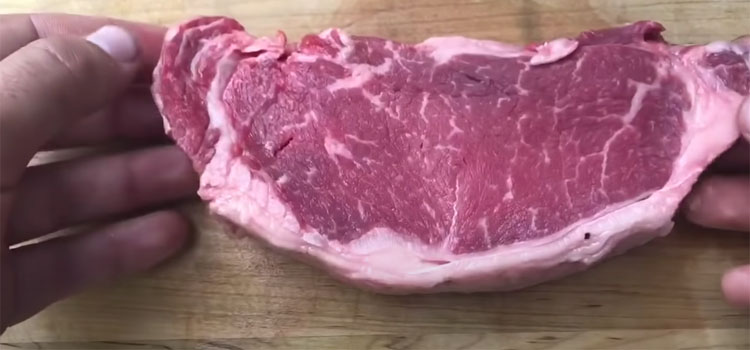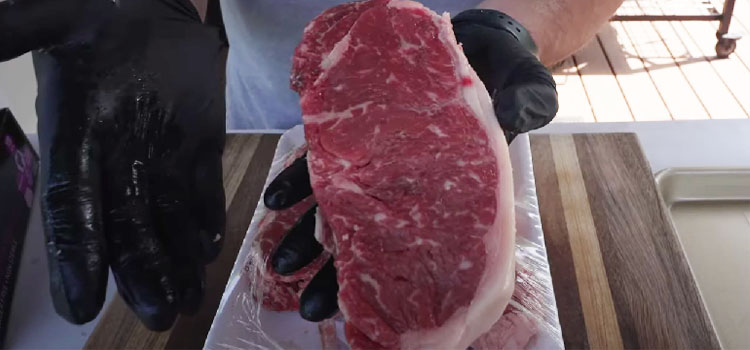Last Updated on September 15, 2024 by Shari Mason
**Is it worth trimming the fat off a New York strip steak?** Some folks might scratch their heads thinking about this, but here’s the scoop: no, you actually don’t need to. The fat adds so much *flavor* and keeps things juicy, kinda like butter melting on hot pancakes. Imagine cutting that off! According to steak lovers and expert chefs, leaving the fat on gives that rich taste and nice juice we crave. If you’re worried about health, just don’t eat the fat. When cooking, that strip of fatty goodness bastes the meat, making every bite mouthwateringly tender and yummy. By the way, keeping the fat means you’ll savor every bite. Check steak forums and recipes from top chefs—most would nod in agreement. So next time, no need to fuss with your knife; let that fat do its magic!
I’ve wondered about this as someone who loves to cook and explore different flavors.
Today, we’ll dive into the steak world and discuss whether trimming the fat is necessary. Read on to find out the secrets to achieving a delicious balance of taste and tenderness in a New York strip steak.
Should I Trim Fat Off New York Strip Steak?


The decision to trim the fat off a New York strip steak [1] depends on personal preference and desired culinary experience.
The fat within the steak plays a crucial role in flavor and tenderness, imparting a rich, buttery essence and contributing to the meat’s juiciness.
“I’m a grandma, so I like cooking for my boyfriend and watching a movie. I cook a lot, actually. I’ll make bacon-wrapped asparagus, steak, and pesto pasta with chicken, but we go out to dinner a fair amount, too.”
– Gigi Hadid, Model
However, excessive fat can result in a greasy mouthfeel or uneven cooking.
Some individuals prefer to trim the fat before cooking to have more control over the fat level, while others appreciate the enhanced flavor and moistness that the fat provides.
But should you use rosemary or thyme for steak?
What Role Does Fat Play In New York Strip Steak?
Fat is significant in New York strip steak, contributing to its flavor and tenderness. The marbling—the intramuscular fat—found in the steak adds a luxurious buttery essence that enhances the overall taste.
It provides moisture and juiciness, resulting in a more succulent and enjoyable eating experience.
The delicate pockets of fat within the meat also melt during cooking, contributing to the steak’s tenderness by keeping it moist and preventing it from drying.
However, it’s essential to strike a balance, as excessive fat can lead to a greasy mouthfeel or interfere with even cooking.
Read:
Should Fat Be Trimmed Before Or After Cooking?


Whether to trim the fat [2] off a New York strip steak before or after cooking is a matter of personal preference and cooking approach.
Some individuals prefer to trim the fat before cooking to have better control over the fat level in the final dish.
This allows for a more tailored cooking experience and can prevent excessive grease during cooking. On the other hand, some chefs and cooks choose to cook the steak with the fat intact.
They believe that leaving the fat on enhances the flavor and juiciness of the steak, as the fat melts and bastes the meat during the cooking process. But how should you cut ribeye steak against the grain?
How Does Fat Affect Cooking & Searing?
- Flavor enhancement: A New York strip steak’s fat content contributes to its rich buttery flavor, adding a delightful essence to each bite.
- Moisture retention: The intramuscular fat, or marbling, helps keep the meat moist and juicy during cooking. As the fat melts, it bastes the steak, enhancing its succulence.
- Texture and tenderness: The presence of fat in the steak contributes to its tenderness, creating a more enjoyable eating experience. The marbling melts during cooking, resulting in a tender and melt-in-your-mouth texture.
- Crust development: Fat aids in developing a beautiful crust when searing a New York strip steak. It helps achieve that sought-after caramelized exterior, adding a pleasing texture and flavor contrast.
- Potential for flare-ups: Excessive fat can lead to flare-ups when exposed to high heat, causing uneven cooking and potentially charring the steak’s exterior. Managing the fat content helps control this risk and ensures even cooking.
“In the delicate balance of fat and flavor, the decision to trim or not to trim a New York strip steak becomes a culinary riddle. The answer lies within, where personal preference guides the knife, sculpting a symphony of flavors that dance upon the plate.”
– Eat Pallet Restaurant & Food Advice
What Are The Considerations When Deciding To Trim Or Not To Trim?
- Personal preference: The decision ultimately rests on individual taste and desired flavor profile. Some prefer a leaner steak with less fat, while others appreciate the richness and flavor that fat adds to the meat.
- Fat distribution: Assess the distribution of fat within the steak. If the fat is unevenly distributed or excessively thick in certain areas, trimming it can help promote even cooking and prevent potential flare-ups.
- Flavor balance: Consider the desired balance between flavor and tenderness. Fat contributes to the steak’s taste, but excessive fat can overpower the meat, leading to a greasy mouthfeel. Striking the right balance ensures an enjoyable eating experience.
- Cooking method: Different cooking methods may influence the decision. For example, grilling or broiling a steak with fat intact can add extra flavor and moisture, while pan-searing may require trimming to prevent excessive grease.
- Culinary goals: Consider your overall culinary vision and the dish you prepare. The flavor and tenderness you desire and your guests’ preferences can guide your decision to trim or leave the fat on.
FAQs
u003cstrongu003eHow thick should I cut the New York strip?u003c/strongu003e
The recommended thickness is typically around 1 inch (2.5 centimeters) for optimal cooking. u003cbru003eu003cbru003eThis thickness allows for a nice sear on the outside while ensuring the interior cooks evenly.
u003cstrongu003eHow do you render the fat off a NY strip?u003c/strongu003e
You can sear the steak in a hot skillet or grill to render the fat off a New York strip steak. u003cbru003eu003cbru003eThe heat will gradually melt the fat, causing it to release and create a flavorful crust.
Key Takeaways
Whether to trim the fat off a New York strip steak depends on personal preference and desired culinary outcomes. Fat plays a significant role in flavor and tenderness, adding richness and moisture to the meat.
However, excessive fat can lead to a greasy mouthfeel or uneven cooking. Finding a balance that suits individual tastes and cooking methods is crucial.
Fat distribution, flavor balance, cooking techniques, and personal culinary goals guide decision-making.
By understanding these factors, you can confidently tailor your approach to trimming fat off a New York strip steak, creating a flavorful and tender dining experience that aligns with your culinary vision.
References:
- https://www.bbcgoodfood.com/howto/guide/how-cook-perfect-steak
- https://medlineplus.gov/ency/patientinstructions/000104.htm
- Can You Put an AC Unit in the Kitchen? - September 27, 2024
- What Cheese Does Olive Garden Use? Discover Their Signature - September 27, 2024
- How to Cancel a Pizza Hut Order? Quick & Easy Guide - September 24, 2024


